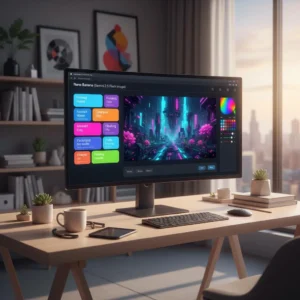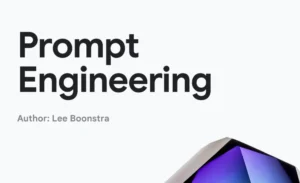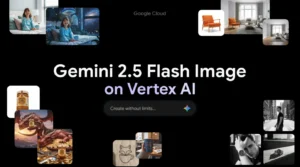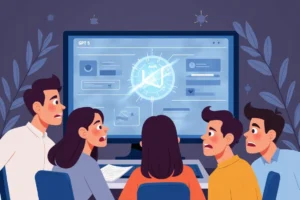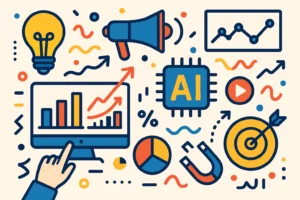Guided Learning Feature in Gemini: Makes Learning Deeper and More Effective
Educational experts and learning scientists have long emphasized that true understanding comes through active engagement, not passive consumption of information. Google recognized this fundamental principle when developing the guided learning feature in Gemini, collaborating closely with educators, cognitive scientists, and pedagogical experts to create an AI tool that actually teaches rather than simply answering questions. This research-backed approach has resulted in a learning companion that uses proven educational methodologies to help students develop deeper understanding and critical thinking skills.
Quick Summary
What is guided learning in Gemini AI?
- Interactive tutoring system that uses step-by-step explanations and Socratic questioning instead of direct answers
- Multimodal learning experience incorporating images, diagrams, videos, and interactive quizzes
- Personalized educational companion that adapts explanations to individual learning needs and pace
- Research-backed approach developed in partnership with educators, cognitive scientists, and learning experts
- Active learning methodology that encourages critical thinking and deep understanding rather than memorization
Key benefits include:
- Breaks down complex problems into manageable steps
- Provides visual aids and multimedia content for better comprehension
- Creates judgment-free learning environment for asking questions
- Adapts teaching style to match individual learning preferences
- Integrates seamlessly with Google Classroom for educators
Understanding Guided Learning in Gemini
The guided learning feature in Gemini represents a fundamental shift in how artificial intelligence supports education. Rather than simply providing quick answers to student questions, this innovative feature acts as a personal learning companion that guides users through complex topics using proven educational methodologies.
At its core, guided learning transforms the traditional AI interaction model by emphasizing understanding over answers. When students engage with this feature, they enter into a dynamic conversation where Gemini asks probing questions, provides step-by-step explanations, and helps learners discover concepts through active participation rather than passive consumption.
The Science Behind Guided Learning
Google developed this feature based on extensive research in learning science and cognitive psychology. The company established a cross-disciplinary team of AI experts, neuroscientists, and cognitive scientists who worked closely with external learning experts to ensure the tool follows proven educational principles.
The guided learning feature leverages LearnLM, a family of models specifically fine-tuned for educational purposes and grounded in educational research. This specialized approach ensures that Gemini’s teaching methods align with best practices in pedagogy and learning science.
Research consistently shows that people learn best when they actively engage with information rather than simply receiving it. This principle forms the foundation of guided learning’s approach, encouraging students to think critically about concepts and build understanding through structured exploration.
Useful Articles:
How Guided Learning Works
Socratic Method Implementation
The guided learning feature employs the Socratic method of teaching, a time-tested educational approach that uses questions to stimulate critical thinking and illuminate ideas. When students ask about a topic, Gemini doesn’t immediately provide the answer. Instead, it begins a dialogue by asking what the student already knows or thinks about the subject.
This questioning approach serves multiple purposes:
- Activates prior knowledge to build connections with new information
- Identifies knowledge gaps that need additional attention
- Encourages active thinking rather than passive information absorption
- Builds confidence through guided discovery of correct answers
Step-by-Step Learning Process
Unlike traditional AI responses that deliver comprehensive answers immediately, guided learning breaks down complex topics into manageable segments. Each step builds upon the previous one, ensuring students develop a solid foundation before moving to more advanced concepts.
The process typically follows this pattern:
- Initial assessment through open-ended questions about the topic
- Concept introduction with basic explanations and visual aids
- Knowledge checking through interactive questions and examples
- Progressive deepening with more complex aspects of the subject
- Application exercises to reinforce understanding
Multimodal Learning Experience
The guided learning feature provides rich, multimodal responses that cater to different learning styles. Students receive not just text explanations, but also:
- High-quality images and diagrams that illustrate complex concepts visually
- Educational videos including relevant YouTube content integrated directly into responses
- Interactive quizzes that test comprehension and reinforce learning
- Custom visual aids generated specifically for the topic being studied
This multimedia approach recognizes that learners process information differently and provides multiple pathways to understanding the same concept.
Key Features and Capabilities
Adaptive Learning Technology
Guided learning adapts its explanations and teaching approach based on individual learner needs. The system monitors student responses and adjusts its methodology accordingly, providing additional clarification when confusion is detected or accelerating the pace for quick learners.
This adaptability ensures that each learning session is personalized to the student’s current understanding level and learning preferences. The AI can recognize when alternative explanations or teaching methods might be more effective for a particular learner.
Comprehensive Subject Coverage
The guided learning feature supports learning across a wide range of academic subjects and topics. Students can use it for:
- Complex mathematics problems with step-by-step problem-solving guidance
- Scientific concepts including biology, chemistry, and physics topics
- Essay writing and structure with argument development support
- Test preparation across various subjects and grade levels
- General knowledge exploration in areas of personal interest
Integration with Educational Tools
Google designed guided learning to work seamlessly with existing educational infrastructure. Educators can easily share guided learning sessions with students through Google Classroom integration, making it simple to incorporate AI-assisted learning into traditional classroom settings.
This integration supports teachers by providing them with a powerful tool that complements rather than replaces traditional instruction methods.
Useful Articles:
Benefits for Different Types of Learners
Visual Learners
Students who learn best through visual information particularly benefit from guided learning’s multimedia approach. The feature automatically generates relevant images, diagrams, and visual representations when explaining complex concepts. This visual support helps clarify abstract ideas and makes difficult topics more accessible.
Auditory Learners
The conversational nature of guided learning appeals to auditory learners who process information best through discussion and verbal explanation. The back-and-forth dialogue format mimics the experience of working with a human tutor, providing the verbal interaction these learners need.
Kinesthetic Learners
Interactive quizzes and hands-on problem-solving exercises within guided learning sessions engage kinesthetic learners who prefer learning through active participation. The feature encourages students to work through problems themselves rather than simply observing solutions.
Self-Paced Learners
Guided learning creates a judgment-free environment where students can ask questions without fear of embarrassment. This supportive atmosphere particularly benefits learners who prefer to work at their own pace and need additional time to process complex information.
Practical Applications in Education
Homework Assistance
Students can use guided learning for homework help that goes beyond simple answer-checking. Instead of providing direct solutions, the feature guides students through problem-solving processes, helping them understand the underlying concepts and develop independent thinking skills.
Exam Preparation
The feature excels at test preparation by breaking down complex topics into study-friendly segments. Students can work through practice problems, review difficult concepts, and test their understanding through interactive quizzes.
Research and Writing Support
Guided learning helps students with research projects and essay writing by teaching them how to structure arguments, develop thesis statements, and organize their ideas logically. The AI guides students through the writing process rather than writing for them.
Concept Reinforcement
Teachers can use guided learning to reinforce classroom concepts by assigning specific topics for students to explore through the AI tutor. This approach provides additional practice and explanation outside of regular class time.
Useful Articles:
Technical Implementation and Accessibility
Gemini 2.5 Pro Integration
Guided learning operates on Gemini 2.5 Pro, Google’s most advanced language model optimized for educational applications. This powerful foundation enables the feature to understand complex educational contexts and provide sophisticated, pedagogically sound responses.
Device Compatibility
Students can access guided learning through the Gemini app on various devices, making it available whenever and wherever learning needs arise. This accessibility ensures that quality educational support isn’t limited by location or time constraints.
Language Support
While initially launched with English language support, guided learning reflects Google’s commitment to making AI education tools available to learners worldwide. The feature is part of Google’s broader initiative to democratize access to quality educational resources.
Educational Philosophy and Methodology
Constructivist Learning Approach
Guided learning embraces constructivist learning principles, which emphasize that learners actively build knowledge through experience and reflection. Rather than passively receiving information, students engage in meaningful dialogue that helps them construct their own understanding.
Critical Thinking Development
The feature specifically targets critical thinking skills by encouraging students to analyze, evaluate, and synthesize information. Through careful questioning and guided exploration, learners develop the ability to think deeply about complex topics.
Metacognitive Awareness
Guided learning helps students develop metacognitive skills by making them aware of their own thinking processes. The AI regularly asks students to reflect on what they understand and what they need to explore further.
Comparison with Traditional AI Tools
Beyond Simple Answers
Traditional AI chatbots focus on providing quick, direct answers to user questions. While efficient for fact-checking, this approach often leaves learners without deep understanding of the underlying concepts.
Guided learning deliberately takes a different approach by slowing down the learning process and ensuring students engage with material at a meaningful level. This methodology produces better long-term retention and understanding.
Educational vs. Information Retrieval
Standard AI tools excel at information retrieval but often fail to support genuine learning. Guided learning specifically addresses this limitation by incorporating proven teaching methodologies and learning science principles.
Engagement and Retention
The interactive nature of guided learning promotes higher engagement levels compared to passive information consumption. Students report better retention and understanding when using guided learning compared to traditional search-based AI interactions.
Implementation in Educational Settings
Classroom Integration Strategies
Educators can incorporate guided learning into their teaching through several approaches:
- Supplemental instruction for students who need additional explanation of classroom concepts
- Homework assignments that require guided exploration of specific topics
- Group learning activities where students work together through guided learning sessions
- Individual tutoring support for students who need personalized attention
Teacher Training and Support
Google provides educational resources to help teachers effectively integrate guided learning into their instruction. These materials explain how to use the feature as a teaching tool rather than a replacement for human instruction.
Assessment and Progress Tracking
While guided learning doesn’t replace formal assessment, it provides valuable informal feedback about student understanding through the interactive questioning process. Teachers can use this information to identify areas where students need additional support.
Student Success Strategies
Maximizing Learning Effectiveness
Students can get the most from guided learning by:
- Engaging honestly with questions rather than trying to guess “correct” answers
- Taking time to think before responding to prompts
- Asking follow-up questions when concepts remain unclear
- Practicing regularly to build understanding over time
- Connecting new learning to previously understood concepts
Building Independent Learning Skills
Guided learning helps students develop self-directed learning abilities by teaching them how to ask good questions, seek appropriate resources, and monitor their own understanding. These metacognitive skills transfer to other learning situations.
Creating Effective Study Habits
The structured approach of guided learning can help students develop better study habits by showing them how to break down complex topics systematically and engage actively with learning materials.
Guided learning in Gemini represents a significant advancement in AI-powered education, transforming artificial intelligence from a simple information provider into a sophisticated learning companion. This innovative feature combines proven educational methodologies with cutting-edge technology to create personalized, engaging learning experiences that help students build genuine understanding rather than just memorizing answers. By embracing the guided learning feature in Gemini, students gain access to a patient, knowledgeable tutor that adapts to their individual needs and helps them develop critical thinking skills essential for academic success.
Sources:
https://blog.google/outreach-initiatives/education/guided-learning/
https://blog.google/products/gemini/new-gemini-tools-students-august-2025/
https://blog.google/products/gemini/google-ai-pro-students-learning/






